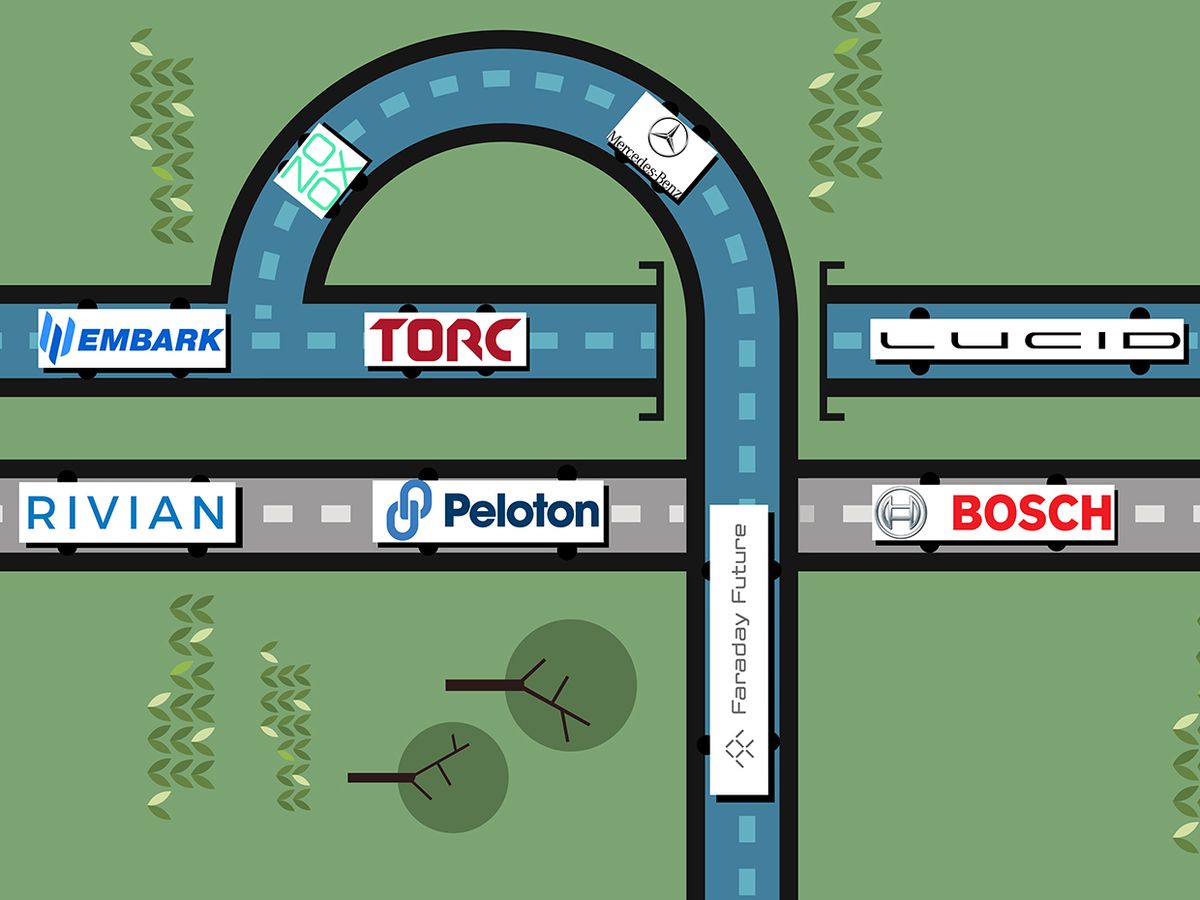You’ve probably heard of Mcity, the fake city built by the University of Michigan to test self-driving cars in Ann Arbor. GoMentum Station in the Bay Area has also been in the news, with Apple and Otto looking for a secure location to put highly automated vehicles through their paces.
But there is a facility in rural California where companies have quietly tested autonomous vehicles for decades without anyone noticing. Crows Landing Air Facility is a 1,500-acre former air base near Modesto with two vast concrete runways, surrounded by farmland.
According to documents sourced by IEEE Spectrum through public records requests, some of Silicon Valley’s hottest automotive startups have used Crows Landing for secret self-driving tests. In the past 18 months, Faraday Future, Lucid, Torc, Rivian, and Zoox have all tested prototype cars there, along with automated semi-trailer trucks from Peloton and Embark. Mercedes-Benz and Bosch also carry out regular automotive experiments at the facility.
“We have multiple year-over-year relationships with several car companies and vehicle testing firms,” confirmed Keith Boggs, assistant executive officer for Stanislaus County, which owns Crows Landing. “The reason why these firms are so attracted to Crows Landing is because it’s so remote.”
Crows Landing’s nearest neighbors are empty fields, but it is just one mile from Interstate 5, and only about 90 minutes by car from San Jose. And it has other advantages. Unlike GoMentum Station, which is still partly controlled by the military, Crows Landing has no restrictions on foreign nationals, who make up a significant part of many autonomous-technology engineering teams. Crows Landing is also cheap, costing as little as US $600 a day to rent the entire facility, according to county documents.
Stanislaus County records show that some firms head out to Crows Landing almost every month. Bosch leads the tally, racking up more than 70 visits since 2015, but Embark and Peloton are close behind, with 49 and 31 truck test days, respectively. That is likely because California still does not allow autonomous commercial vehicles like semi trucks to be tested on public roads.
Another regular visitor is Lucid, which is developing a semiautonomous luxury electric sedan. Although Lucid is seeking funds (or possibly a buyout) to fund an assembly plant in Arizona, the startup has missed only a handful of months at Crows Landing since the start of 2016.
Other companies visit less frequently, or hardly at all. The much-troubled Faraday Future tested at Crows Landing every day for a week last March but has not returned since. After an intensive test campaign in the summer of 2016, low-profile startup Torc has been similarly absent. Newcomers Rivian and Zoox have racked up only a handful of visits between them.
None of the companies contacted by IEEE Spectrum provided a comment about testing at Crows Landing.

The facility was built hurriedly in the early years of World War II, as an auxiliary air station to the Alameda Naval Air Station near San Francisco. The Navy then turned it over to NASA’s Ames Research Center in 1994. In 1997, Crows Landing was the venue for some of the first road tests [PDF] of vehicle-to-vehicle (V2V) technology in autonomous cars, conducted by Petros Ioannou of the University of Southern California. After hosting sporadic car and drone tests, NASA passed the old air base along to Stanislaus County in 1999.
Little happened at Crows Landing for more than a decade until, in early 2014, Tesla rented the base for a test run of an unnamed prototype electric vehicle—probably the Model 3. Shortly after, the Discovery Channel TV show “Mythbusters” used Crows Landing for an episode about “drifting” cars.
“After that, we started to get more and more activity to the point where we had to hire security and really tighten it up,” remembers Boggs. “You know, people were out there driving very fast.”
Mercedes-Benz was one of the first car companies to sign an agreement to use the base for testing, followed by Bosch and Volkswagen. Lucid was the first startup to discover the site, early in 2016. By the end of 2017, Crows Landing had hosted around 260 automotive test days, as well as numerous club days for owners of luxury and sports cars.
But the glory days for Crows Landing as a clandestine autonomous testing ground could be numbered. Self-driving technologies are quickly improving, and states like Florida, Michigan, and Arizona have few restrictions on testing automated vehicles in public. Bookings by self-driving car companies for 2017 were about 20 percent lower than 2016.
That does not worry Keith Boggs unduly. Stanislaus County has a long-term plan to turn Crows Landing into an industrial business park, complete with an airstrip for tech tycoons to fly planes (or possibly electric-drone taxis) to the Bay Area in under half an hour.
“We’re happy to have reputable tech-based testing on site for the next few years,” he says. “And we like to think that as we start to put infrastructure in the ground, some of those automotive relationships could turn into corporate entities and job creation.”
Editor’s note: This story was updated on 01 February 2018.
Mark Harris is an investigative science and technology reporter based in Seattle, with a particular interest in robotics, transportation, green technologies, and medical devices. He’s on Twitter at @meharris and email at mark(at)meharris(dot)com. Email or DM for Signal number for sensitive/encrypted messaging.



